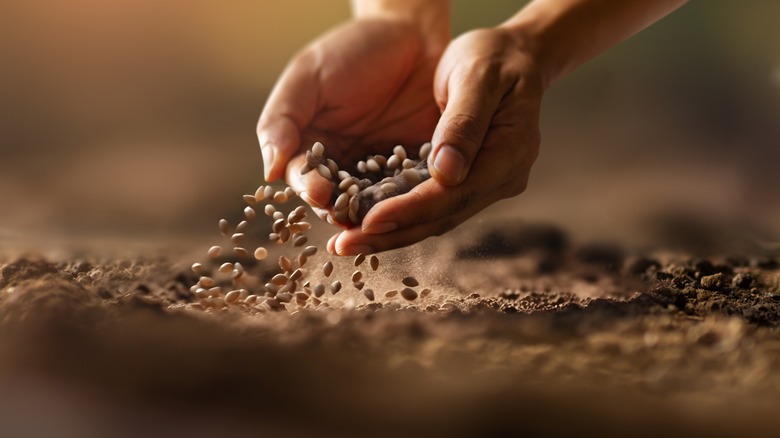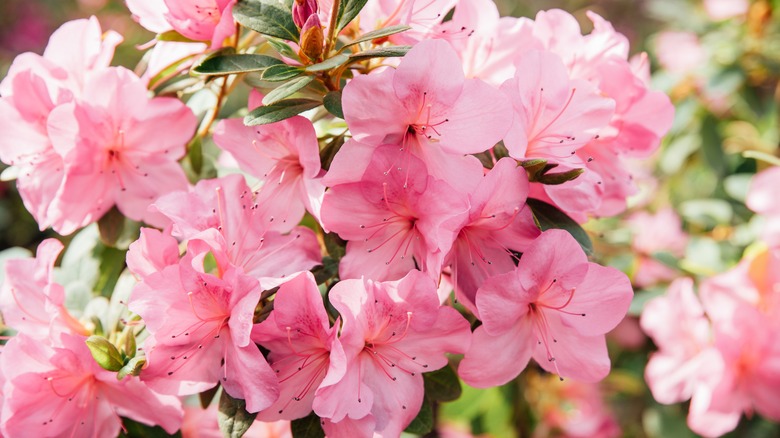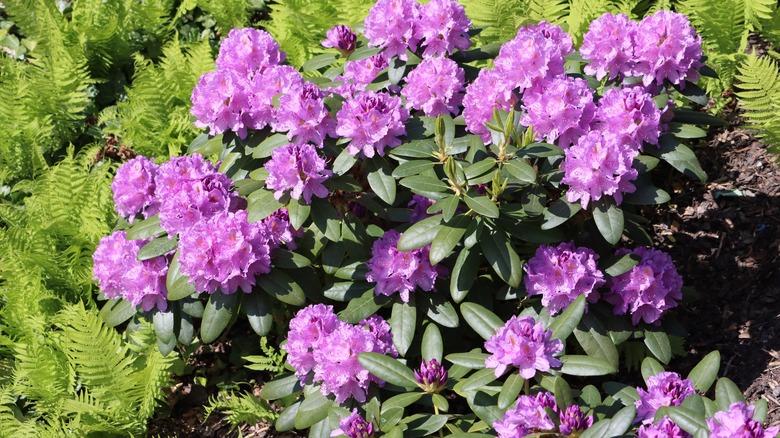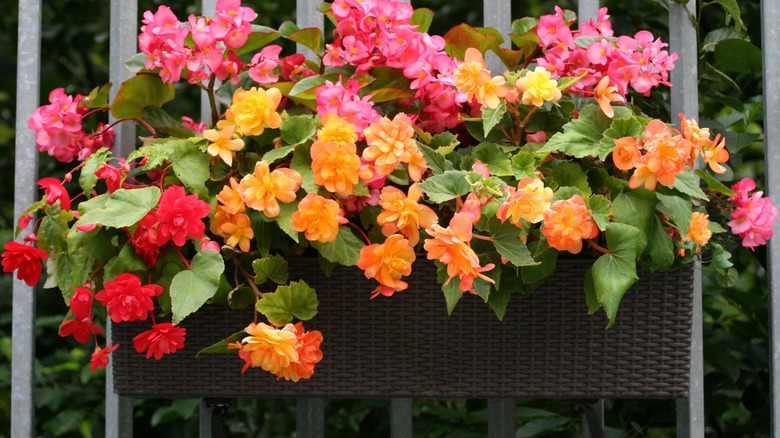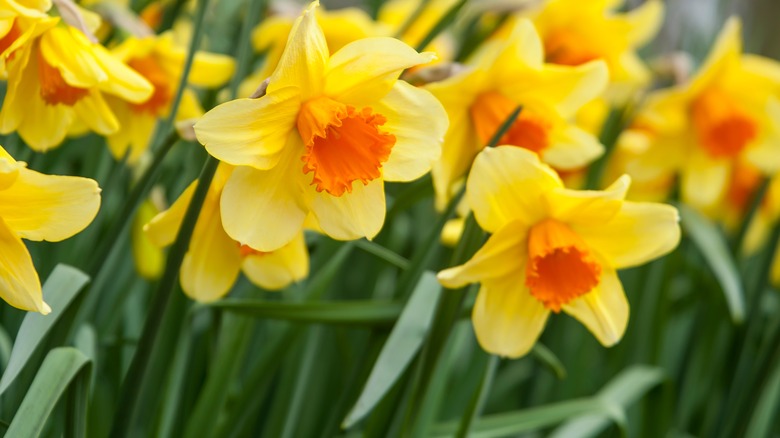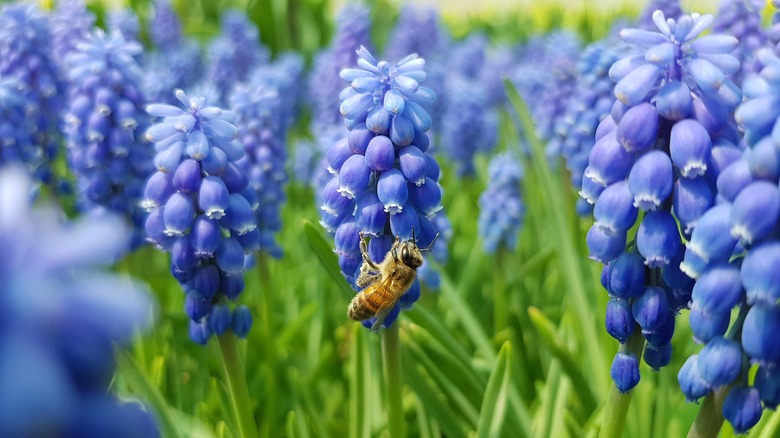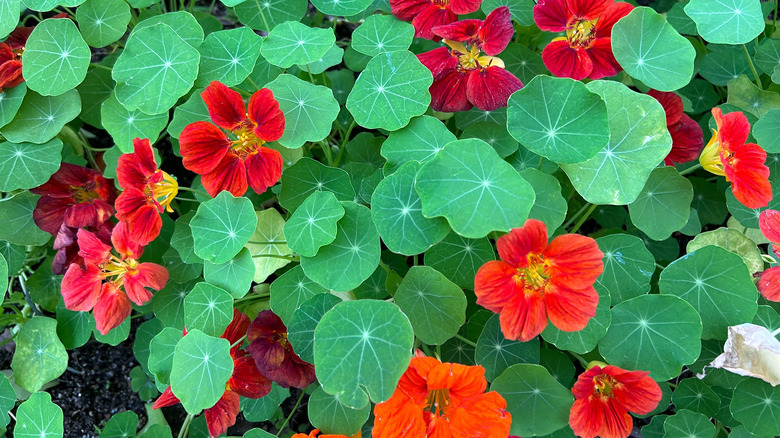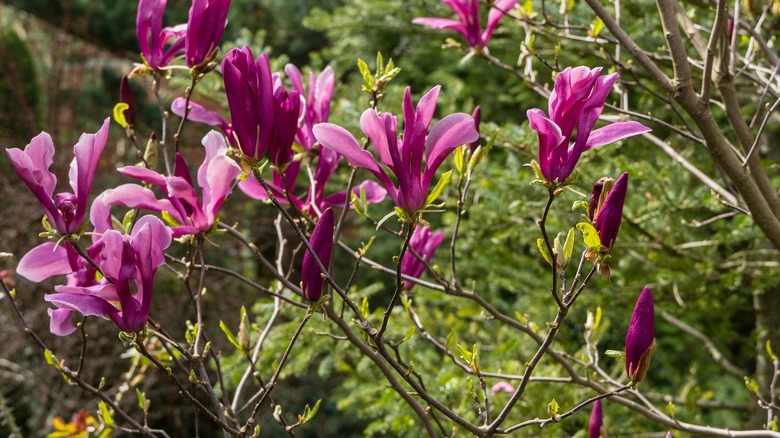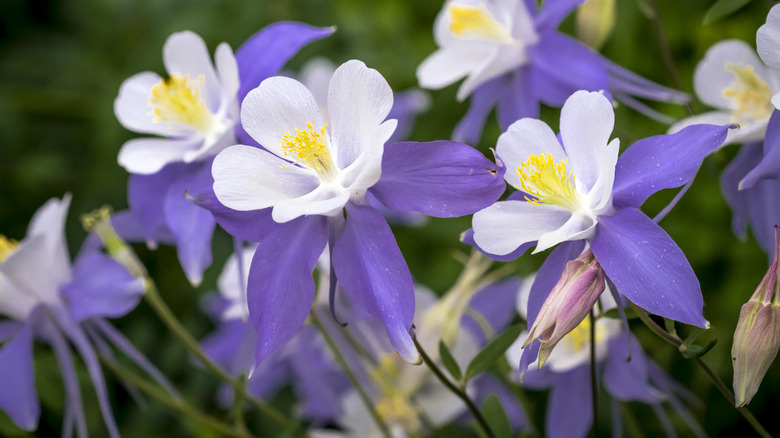8 Colorful Plants That Will Thrive In Your Garden's Acidic Soil
If you live on the east coast or in the southeastern region of the US, it's more likely than not that your soil pH is in the acidic range (less than 7 on the pH scale). Soil acidification can occur based on a variety of factors, including plant decay, rainfall, fertilizer, and chemical reactions within the soil, according to a recent study from Oklahoma State. If your area is naturally rich in acidic soil, you may have found yourself frustrated year after year when your home garden fails to thrive. In that case, it may be your choice of plants that's affecting your garden's growth: some plants, like lily of the valley or lavender, thrive in alkaline soils, while others grow best in neutral to acidic soil. Any extreme variations in pH towards the very acidic or very alkaline can affect the availability of nutrients in your soil, and can make gardening a challenge; if your soil is extremely high or low in pH, consider taking measures to balance it. But if adjusting your soil's pH proves difficult or infeasible, and you know your soil leans toward the acidic, don't fret: these colorful plants will not only survive, but thrive, in acidic soils.
Azaleas bloom in a rainbow of colors
Azaleas can sport beautiful flowers in shades of pink, red, purple, and orange in North America, and can be planted in the fall to ensure blooms in the spring. Azaleas enjoy partial shade, well-draining soil, and plenty of water, especially in a warmer environment. Investing in azaleas can pay off year after year: though US-native azaleas drop their leaves in the winter, these pretty shrubs are perennials, and if cared for properly, they'll rebloom each spring. Azaleas love acidic soil, so you should be cautious planting them if your soil tends to be more alkaline. However, azaleas can be planted in raised beds or containers in areas where alkaline soil is prevalent. Finish pruning your azaleas by late June in the US; since azaleas can range from anywhere between 3 and 20 feet tall and wide, pruning at the right time can be essential to containing growth and preserving the health of your garden.
Rhododendrons are perfect shrubs for a sun-dappled spot
Azaleas are technically a subset of the rhododendron family, so it will be no surprise that other plants in this genus do well in acidic soils, too. Unlike azaleas, rhododendrons are evergreen, maintaining their leaves year-round, and tend to have larger flowers. They share some of the particularities of azaleas when it comes to care. However, both azaleas and rhododendrons have shallow roots that require moist, well-draining soil to thrive. And like azaleas, rhododendrons do best in partial shade, as intense direct sunlight can bleach their leaves. You can gauge how much sun a rhododendron requires based on leaf size: the larger the leaf, the more shade the plant likely needs. Rhododendrons similarly boast a wide assortment of eye-catching colors, including orange, yellow, red, pink, blue, and white. A rhododendron bush can be a dramatic statement piece within your acidic garden with its large, ample blooms.
Begonias are a colorful but easy addition if you have acidic soil
Begonias flower in all colors except blue. If the sheer variety of begonia species available isn't enough to sell you on these beautiful blooms, perhaps their versatility and ease of care will. Begonias can be both indoor and outdoor plants and require indirect light, a moderate amount of water, and occasional pruning after their flowers bloom. Like other acid-loving, shallow-rooted plants, they require good drainage. This will prevent root rot, which begonias can be prone to if placed in the wrong growing medium. To avoid the common problem of leggy stems on your begonia plants, be sure to prune and deadhead regularly.
If you find your garden has little, if any, direct sunlight, you can still enjoy the beautiful colors of a flowering plant by choosing begonias. Some varieties of begonia may be scorched by direct sunlight, so they thrive best in partial shade — essential to keep in mind when choosing a spot for them in your garden.
Daffodils are a low-maintenance option for acidic soil gardens
Daffodils are among the first flowers to emerge in the springtime, and their yellow, orange, and white blooms can herald a bright growing season to come. Comfortable in slightly acidic soil, these classic flowers can be sown directly into the ground or in containers, and their bulbs can be harvested yearly to ensure returning blooms. Daffodils grow best when their bulbs are planted in late fall, before hard frost. After the leaves die and turn brown, you can trim the foliage at the soil line. These perennials require moist soil and enjoy direct sunlight. Daffodils are perhaps one of the most low-maintenance choices for your acidic-soil garden: they do not need to be watered over the summer months, when the plants will go dormant. They are perfect for anyone planning summer travel who may be worried about their garden's blooms while they're away!
Grape hyacinths grow well in acidic soil, in shady spots
Grape hyacinths join daffodils as perennial early-spring blooms, with delicate, small flowers. Grape hyacinths bloom in a purple, blue, white, and pink color range. Also known as muscari, these bulbs can be planted in late fall and essentially left alone until springtime. Grape hyacinths prefer slightly acidic soil (6.0 to 7.0), can tolerate partial sun, and are best grown directly in outdoor soil. Grape hyacinths differ from hyacinths in that they can not be rebloomed in indoor containers. But, grape hyacinths will give you plenty of bang for your buck: like other bulb plants, grape hyacinths will develop sister bulbs over time for even more blooms each year, spreading into a wide, flower-dense groundcover. Grape hyacinths can be planted in wooded, shady areas at the foot of trees and shrubs since their bloom time precedes most leaf growth for deciduous plants. If your garden has an abundance of shady trees and shrubs, grape hyacinths will allow you to add a pop of color to your space before the greenery grows in.
Nasturtiums add some fiery color to your acidic-soil garden
The rich red, yellow, and orange blooms of nasturtiums are gorgeous enough on their own to make a fine addition to any acidic-soil garden. But these fiery annuals offer additional benefits you might not expect; not only do nasturtiums repel insects naturally, but they grow edible flowers and leaves that can be added to salads and other summertime dishes. They thrive in well-draining soil and bloom best in full sun. They can also make helpful companion plants in a veggie garden. When planted next to vegetables like squash, tomatoes, and cucumbers, nasturtiums will fight common pests and draw pollinators to your crops. As with other annuals, it's best to start nasturtium seeds indoors 4 to 6 weeks prior to your area's last frost. Water your nasturtiums deeply, but don't water too frequently as they are susceptible to root rot.
Magnolias are an acid-tolerant option for larger spaces
If you're looking to add a larger acid-tolerant plant to your garden, it's worth considering magnolias. Magnolias grow as large shrubs or trees, and sport white, pink, yellow, or purplish flowers. They're fragrant plants that prefer slightly acidic soil, but they'll survive in neutral to slightly alkaline soils as well. They require full sun to partial shade and soil that isn't overly wet. Magnolia saplings can be planted in fall or late spring and should be placed in an area of your garden where strong winds won't damage them. If you find your magnolia prospering and want to propagate it further, you can do so by layering, or pinning low shoots to the soil so that they take root as new plants.
Among the perennial flowering shrubs and trees available in North America, magnolias should be a top choice; many varieties of magnolia are non-invasive and sustainable alternatives to flowering trees like the Bradford Pear.
Columbines make a hardy addition to any acidic garden
For unique perennial blooms of every color, size, and shape, look no further than columbines. These gorgeous flowers prefer slightly acidic to neutral soil, moderate moisture, and full sun to partial shade. Seeds can be sown in the fall for springtime flowers and will flower again and spread yearly. Columbines come in purples, dark pinks, reds, yellows, and more. Some sport spindly hanging blooms while others have star-shaped petals or more rounded flower shapes. Proper columbine cultivation and care may yield beautiful results for your garden: in addition to their bright, colorful, and distinctive flowers, columbines attract pretty pollinators such as hummingbirds and hawk moths. Start inside 6 weeks before the last spring frost and transplant once the danger of frost is gone. With minimal fertilization and pruning required, columbines are among our favorite recommendations for acidic-soil gardens.
